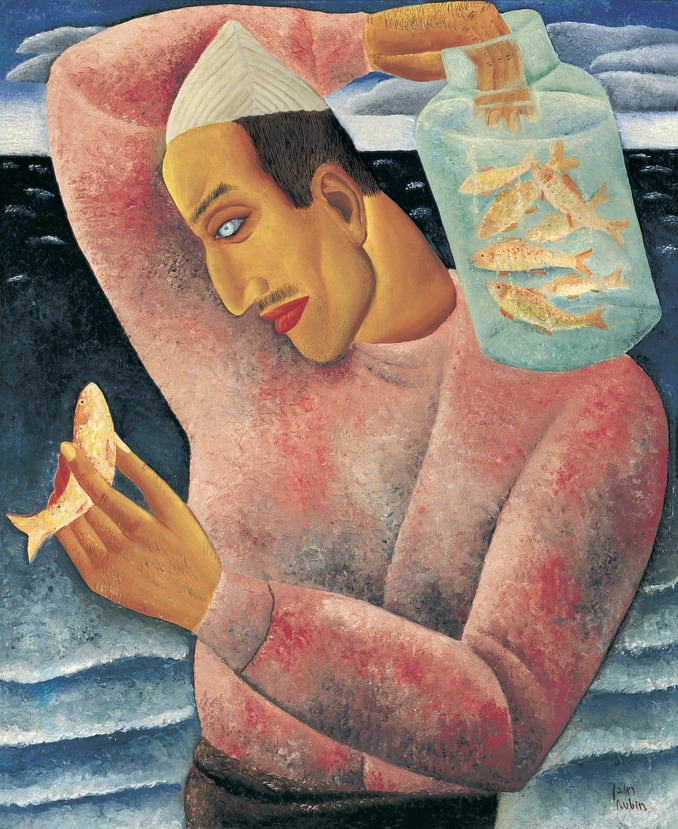
- Artist/Maker:
- Reuven Rubin
- Bio:
- Israeli, b. Romania, 1893-1974
- Title:
- Goldfish Vendor
- Date:
- 1928
- Medium:
- Oil on canvas
- Dimensions:
- 28 5/8 × 23 1/8 in. (72.6 × 58.8 cm)
- Credit Line:
- Gift of Kitty and Harold J. Ruttenberg
- Accession Number:
- 1985-227
On View
By 1920, many young artists in Israel had reacted against the classical Western orientation of Jerusalem's Bezalel Academy. They became disenchanted with the use of Oriental motifs and local landscape in the service of biblical subjects. Instead, these painters and sculptors-who knew contemporary European artistic developments firsthand- sought to incorporate everyday visions of the Near East into a modernist vocabulary. Thus, influenced by the newly adopted use of the modern Hebrew language, they defined their goals for a "Hebrew" rather than a "Jewish" art.
Reuven Rubin was one of the most important of these young pioneers, and his new land was a constant source of inspiration for him. The lyricism of his Goldfish Vendor (also known as Arab Fisherman) is typical of Rubin's colorful and self-consciously naive vision of the Land of Israel. The painting also exemplifies a theme recurrent in Israeli art of that decade-the portrayal of the Arab. The appeal of the physical vitality of these people becomes almost stereotypical in the literature and art of the 1920s. According to Nahum Gutman, Rubin's colleague, the Arab who maintained a continuing tie with the land constitutes the antithesis of the Diaspora Jew. His sense of belonging and his instinctual assets are exaggerated, even monumentalized.
Rubin's paintings of that period have been stylistically linked to the earlier French naïfs such as Henri Rousseau and André Bauchant. Also evident is the debt owed to the Jewish members of the School of Paris, particularly Modigliani, whose monumental figures seem to press the edges of the canvas and could easily have served to trigger Rubin's powerful figure. Yet Rubin's subject matter and purposefully innocent style must also be viewed in light of other Israeli paintings of the decade; their pervasive aesthetic combined the tenets of modernism with a confident depiction of the land, creating a style appropriate for the infancy of Israel's national rebirth.
Reuven Rubin was one of the most important of these young pioneers, and his new land was a constant source of inspiration for him. The lyricism of his Goldfish Vendor (also known as Arab Fisherman) is typical of Rubin's colorful and self-consciously naive vision of the Land of Israel. The painting also exemplifies a theme recurrent in Israeli art of that decade-the portrayal of the Arab. The appeal of the physical vitality of these people becomes almost stereotypical in the literature and art of the 1920s. According to Nahum Gutman, Rubin's colleague, the Arab who maintained a continuing tie with the land constitutes the antithesis of the Diaspora Jew. His sense of belonging and his instinctual assets are exaggerated, even monumentalized.
Rubin's paintings of that period have been stylistically linked to the earlier French naïfs such as Henri Rousseau and André Bauchant. Also evident is the debt owed to the Jewish members of the School of Paris, particularly Modigliani, whose monumental figures seem to press the edges of the canvas and could easily have served to trigger Rubin's powerful figure. Yet Rubin's subject matter and purposefully innocent style must also be viewed in light of other Israeli paintings of the decade; their pervasive aesthetic combined the tenets of modernism with a confident depiction of the land, creating a style appropriate for the infancy of Israel's national rebirth.
Information may change as a result of ongoing research.